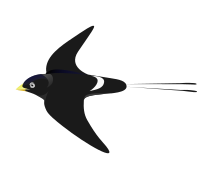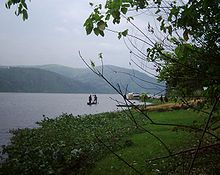River martin
| River martins | |
|---|---|

| |
| White-eyed river martin (Pseudochelidon sirintarae) | |
| Scientific classification | |
| Domain: | Eukaryota |
| Kingdom: | Animalia |
| Phylum: | Chordata |
| Class: | Aves |
| Order: | Passeriformes |
| Family: | Hirundinidae |
| Subfamily: | Pseudochelidoninae Shelley, 1896 |
| Genus: | Pseudochelidon Hartlaub, 1861 |
| Type species | |
| Pseudochelidon eurystomina[1] Hartlaub, 1861
| |
| Species | |
The river martins form a distinctive subfamily Pseudochelidoninae within the
When the African river martin was first discovered in the 19th century,
The African river martin has a restricted distribution; it appears to be locally numerous, although its true status has not been fully investigated. The white-eyed river martin was discovered as recently as 1969 and is only known from specimens and anecdotal evidence – no modern
Taxonomy
When a specimen of the African river martin from Gabon was first formally described by German zoologist Gustav Hartlaub in 1861,[2] it was not initially identified as a member of the swallow and martin family. Hartlaub placed it with the rollers, and later authors either put it in its own separate family, or with the woodswallows. It was only following study of the anatomy of the species by Lowe that it was determined to be closely related to the swallows and martins, but sufficiently different that it could be placed in a separate subfamily Pseudochelidoninae.[3] The genus name Pseudochelidon comes from the
For many years the African river martin was the sole member of its genus and subfamily until the discovery of the white-eyed river martin, Pseudochelidon eurystomina, by Thai ornithologist Kitti Thonglongya in 1968.[6] Although some authorities follow Brooke in placing that species in a separate genus Eurochelidon due to its significant differences from the African species, it remains a member of the same subfamily.[7][8] Genetic studies confirmed that the two river martins form a distinct clade from the typical swallows in the Hirundininae subfamily.[9]
The river martins are in some ways intermediate between typical swallows and other
Description
Both species are medium-sized (14–18 cm or 5.5–7.1 in), mainly black-plumaged swallows, unlikely to be confused with any other hirundine in their respective ranges. Adults of both species have large, blue-glossed heads, a green tinge to the body plumage, and brown wings. The sexes are similar in plumage. The white-eyed has elongated outer tail feathers, a whitish rump, a white eye and eye-ring, and a yellow bill. The African has a red eye-ring and bill and lacks a contrasting rump patch or tail streamers. The juveniles of both species are similar to the adults, but with brown heads, and young white-eyeds lack the long tail streamers of the adults.[3]
The African river martin has a chee chee or cheer-cheer-cheer call when it is flying in flocks. It is very vocal during migration, giving harsh gull-like calls, and appears to have a jingling courtship song. No calls have been described for the white-eyed river martin.[3]
Distribution and habitat
The two members of the subfamily have geographically separate ranges. The African river martin breeds along the
The African species' breeding habitat consists of forested rivers with islands with sandy shores for breeding. The nesting grounds of the white-eyed river martin are unknown, but if the breeding habitat resembles that of its relative, it is likely to be the forested valleys of large rivers, which can provide sandbars and islands for nesting, and woodland over which the birds can catch insect prey.[3] The African river martin uses coastal savannah as its winter habitat. Based on its only known wintering site, the non-breeding habitat of the white-eyed is assumed to be in the vicinity of open fresh water for feeding, with reed-beds for the night-time roost.[13]
Behaviour

Breeding behaviour is known only for the African river martin. It nests in large colonies of up to 800 birds from December to April, when the river levels are low. Each pair excavates a 1–2 m (39–79 in) long tunnel in the exposed sandbanks. The pocket at the end of the tunnel has a few twigs and leaves to serve as a nest, onto which two to four unspotted white eggs are laid. It has chasing flight displays and will walk on the ground; it also displays on the ground, but the function of this is uncertain. It rarely perches during the breeding season.[3] Although it has been assumed that the breeding habits of the white-eyed species resemble those of the African species, distinctive differences in foot and toe morphology suggest that it might not use a burrow for nesting.[15]
The African river martin feeds in flocks over river and forest, often far from water. It eats
Status

The white-eyed river martin was seen in Thailand in 1972, 1977 and 1980, but not definitely since.
One factor that reduces the chances of re-discovering the white-eyed martin is the drastic decline in the numbers of swallows wintering at
The total population size of the African river martin is unknown. In the late 1980s, it appeared to be common, if local, and large numbers were seen on migration in Gabon. However, it is particularly poorly known in the Democratic Republic of the Congo (DRC), and it is unclear if there is any relationship between the birds breeding in the DRC and those breeding in coastal areas of Gabon and the Republic of Congo. A flock of 15,000 birds was seen in 1997, and a mixed flock with
References
- ^ "Hirundinidae". aviansystematics.org. The Trust for Avian Systematics. Retrieved 2023-07-15.
- S2CID 37517718.
- ^ ISBN 0-7470-3202-5.
- ^ "Scientific bird names explained". uk.r.b. Retrieved 2008-01-03.
- .
- ^ Kitti, Thonglongya (1968). "A new martin of the genus Pseudochelidon from Thailand". Thai National Scientific Papers, Fauna Series No. 1.
- ^ Brooke, Richard (1972). "Generic limits in Old World Apodidae and Hirundinidae". Bulletin of the British Ornithologists' Club. 92: 53–7.
- ^ a b "BirdLife International Species factsheet: Eurochelidon sirintarae ". BirdLife International. Retrieved 2009-11-15.
- PMID 15737595.
- ^ Olson, S L (1973). "A classification of the Rallidae". Wilson Bulletin. 65: 381–416.
- PMID 8516319.
- ^ a b c "BirdLife International Species factsheet: Pseudochelidon eurystomina ". BirdLife International. Retrieved 2009-11-15.
- ^ ISBN 978-0-9552607-3-5.
- ^ a b c d Tobias, Joe (June 2000). "Little known oriental bird: White-eyed River-Martin: 1". Oriental Bird Club Bulletin. 31.
- ^ ISBN 0-946888-44-2. Archived from the original(PDF) on 2011-07-17.
- ^ Tobias, Joe (June 2000). "Little known oriental bird: White-eyed River-Martin: 2". Oriental Bird Club Bulletin. 31.
- ISBN 974-85673-6-2. p233
- ^ a b Judell, Doug (2006). "Investigating a possible sighting of the White-eyed River-Martin". Thaibirding.com. Retrieved 2009-11-13.
- ^ "Appendices I, II and III" (PDF). Convention on International Trade in Endangered Species of Wild Fauna and Flora, valid from 13 September 2007. Retrieved 2008-01-03.
- ^ Angehr, G R; Schmidt, B K; Njie, F; Gebhard, C (May 2005). "Significant records and annotated site lists from bird surveys in the Gamba Complex, Gabon" (PDF). Malimbus. 27: 72. Archived from the original (PDF) on 2011-07-17.
External links
- African river martin videos on the Internet Bird collection
